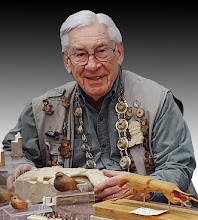Carving a Celtic Love Spoon –
How to
“Where do you start to carve
something like a Celtic Love Spoon?” was the young man’s question. He had picked up the carved spoon and turned
it over in his hands.
I asked him, “Have you ever done any
carving?”
His answer was, “No, but I don’t know
where to start. Do you have a video to
show how to carve something like this?”
In this very “YouTube World” where
you can learn almost anything by clicking on to topic in the YouTube site, this
young man was a product of the new world.
Then just before Christmas, I had the
same question asked of me again, “Do you have a video on how to carve a Love
Spoon?”
Nope… so giving it some thought I
finally came up with an answer and then made a Video of this very idea.
Now carving something as intricate as
the Love Spoon does take time – lots of it.
To try and shoot all the time needed to carve it… would be
impossible. Way too much time involved
in doing that!
So still shots woven together in kind
of a Slide Show is the best answer for something that takes time to do.
Today I unveil my new Video for my
Blog Readers. Just click here and take a
look at the final product. “Carving
Celtic Love Spoons January 2014”
But where do you start to do a spoon? Here is the “How To” just for you.
First there is the pattern… which at
times is pieced together. The Celtic
designs are many… and the people that are interested in “Celtic Things” all
have different things that they like.
Each spoon has a basic structure so
that it will hold up and stay together. As well each one can be very delicate
in its actual make up but if the wood is too thin at any one point it will very
likely break. Just one little one
asking, “Grandma can I hold it…?” will be sure to see a spoon break.
At times my customers are involved in
the process of the design as well.
Just before Christmas I received an
email from California asking if I did commissioned work and explaining that
this fellow would like a special Celtic Knot in a Love Spoon.
He sent patterns and photos of knots
that he liked. Together with an exchange back and forth by email we came up
with almost the right design… at least it was a good and complete design. It
was the start.
I drew the pattern for the Spoon on
paper and then when the cut out was made it was transferred to a plastic sheet
making the pattern long wearing and worth a lifetime of carving. For plastic I
use the flat sheets of plastic cut from boxes and containers that store bought
products come in. These items are
scheduled to be re-cycled. Each flat
sheet makes a great pattern possibility.
Next I transfer the pattern to the actual
wood that I will be using.
In the case of this Celtic Love Spoon
I use recycled wood… and particularly old Mahogany from old houses that are
being torn down or renovated. A local
recycling store, “Re-Store” (connected to Habitat for Humanity) is a great place
to pick up the old lumber. And the quality of the Mahogany is excellent
compared to what is harvested and sold today. It usually has a rich colour and
is very firm to carve. The finish is amazing as well.
After the spoon is roughed out by
cutting around the outline I then cut the center sections out with a scroll
saw. This part is tedious but very helpful in speeding up the process. You could carve the holes but it takes time –
too much time.
Step by step each section of the
spoon is carved carefully. Once the pattern is cut out there are no more changes
that can be made. And also no more mistakes
can be covered up either… so you simply don’t make mistakes!
Finally I begin the slower task of
sanding and smoothing out the carved piece so that the knife cuts can no longer
be seen.
An application of finishes and Tada…
you have a Celtic Love Spoon. And in
this case there are two spoons completed this time around.
A photo will offer you more than 1000
words. You can see all of these
below. And finally having published these
photos to my Blog today – they are now going to show up in “Pinterest”
You can also see these on Facebook at
“Misty Hollow Carving by Murray Lincoln”.
Please drop by and offer a “Like” – it will help me get the word out to
others about the carvings at Misty Hollow.
~ Murray Lincoln ~
Murray Lincoln
https://www.facebook.com/
www.murraylincoln.com
http://mistyhollow-
Twitter Misty Hollow (@misty_hollow)
Blog
http://murraylincoln.blogspot.
My Tatting Blog
http://tattingwhisperer.







